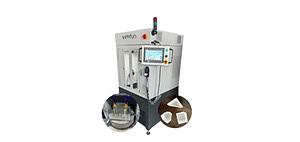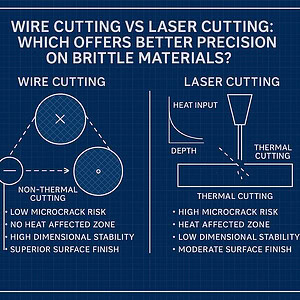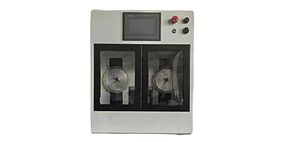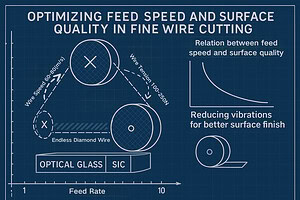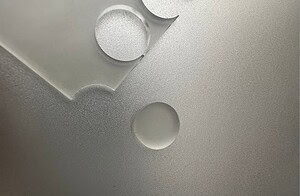Precision wire cutting involves high-speed motion, abrasive interaction, and continuous mechanical loading.
Wire saw safety is essential for preventing contamination, maintaining cutting stability, and protecting both operators and equipment.
This guide outlines engineering-grade safety practices for enclosure design, coolant management, airflow control, and daily operation—especially when processing sapphire, silicon carbide, ceramics, quartz, and carbon-fiber composites.
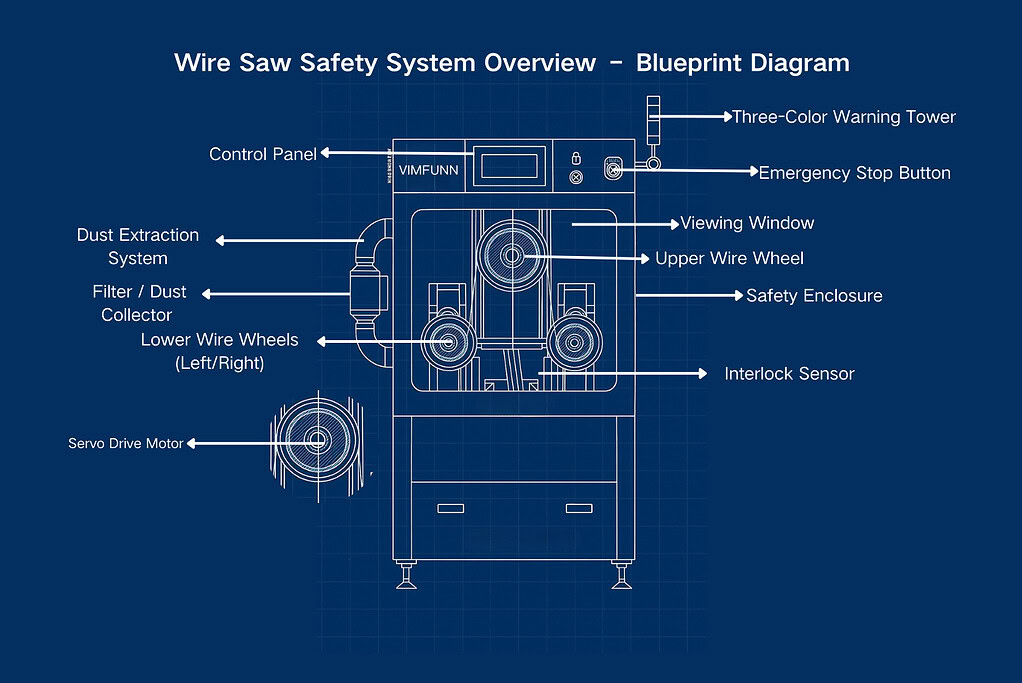
Safety Requirements for Precision Wire Cutting
Achieving clean, stable, and safe operation depends on three engineering pillars:
- Safety enclosure and mechanical protection
- Environmental cleanliness and airflow control
- Coolant selection, filtration, and waste handling
These principles apply to all industrial wire-saws, where rotating wheels, abrasive debris, and thermal loads must be properly controlled.
Safety Enclosure and Mechanical Protection
High-speed wire loops and abrasive particles require a sealed, impact-resistant structure.
Proper enclosure design ensures long-term ワイヤーソーの安全性.
1. Structural safety of the enclosure
A high-quality enclosure must:
- Prevent debris escape Ceramic, quartz, and SiC particles can be ejected at high velocity. A sealed chamber keeps particles contained.
- Withstand wire break impact Although diamond wire loops are highly stable, failures are possible under overload. Reinforced steel frames or impact-resistant polycarbonate prevent operator exposure.
- Maintain negative-pressure airflow Controlled suction ensures dust moves toward filters instead of leaking outward.
- Allow safe observation Windows must use scratch-resistant, shatter-proof materials to withstand abrasive environments.
2. Interlock and active protection systems
Clean and safe cutting requires intelligent fail-safe mechanisms:
- Door-open interlock stops motion instantly
- Wire tension-loss sensors halt the drive system
- Coolant flow detection prevents dry cutting
- Overheat alarms protect motors and bearings
These systems maintain ワイヤーソーの安全性 during unexpected events.
3. Emergency stop architecture
A compliant wire-saw must have:
- Direct electrical cutoff
- Independent drive-motor brake
- Coolant-pump pressure release
- Redundant logic separate from the main controller
This ensures fail-safe shutdown even under software malfunction.
Environmental Cleanliness and Coolant Handling
Coolant greatly affects cutting safety, damage depth, and environmental impact.
1. Why coolant management matters
Coolant stabilizes:
- Temperature → prevents thermal shock in brittle materials
- 潤滑 → reduces abrasive friction
- Particle transport → clears debris from the cutting interface
Poor coolant management increases micro-crack risk and surface defects.
2. Selecting correct coolant
- DI water → quartz, sapphire, optical glass
- Light oil or mist coolant → graphite and carbon composites
- Additives → anti-corrosion, anti-foaming, microbial inhibitors
Correct selection ensures clean cutting operation without residue.
3. Filtration and recycling
A high-precision wire-saw uses:
- Cyclone separation for coarse debris
- 5–10 µm cartridge filtration for fine particles
- Optional membrane filtration for ultra-clean operation
Clean coolant protects grooves, bearings, and wire tension precision.
4. Environmental disposal
Coolant containing SiC or ceramic particles must comply with:
- Industrial wastewater standards
- Heavy-metal monitoring
- Sealed-container transport procedures
This protects both operators and the surrounding environment.
Dust, Swarf, and Airflow Control
A clean cutting environment is a critical part of ワイヤーソーの安全性.
1. High-efficiency dust extraction
A stable dust-control system ensures:
- HEPA filters capture sub-micron particles
- Multi-point airflow removes dead zones
- Pulse-cleaning maintains constant suction
This prevents contamination of bearings and wheel grooves.
2. Swarf management
Abrasive swarf should be collected using:
- Sludge tanks
- Magnetic or gravity separators
- Dry collectors for graphite materials
This prevents re-entrainment in the cutting interface.
3. Cross-contamination avoidance
Switching between materials requires full cleaning to avoid:
- Chemical reaction
- Optical defects
- Mechanical wear
Especially important for semiconductor and optics manufacturing.
毎日 Wire Saw Safety Checklist
(semantic keyword used: checklist)
Operators must inspect the machine before each shift:
- Verify wire tension and running stability
- Inspect enclosure seals
- Check coolant level, temperature, and flow rate
- Confirm filters are clean
- Inspect groove wear on PU/rubber wheels
- Verify wheel alignment and noise levels
- Test emergency-stop function
- Check airflow, dust extraction, and chamber cleanliness
A documented checklist improves repeatability and minimizes downtime.
When Cutting Must Be Stopped Immediately
Stop operation if:
- Wire oscillation or vibration increases
- Coolant becomes cloudy unusually fast
- Abnormal swarf accumulation appears
- Enclosure negative pressure drops
- Unexpected changes in surface finish occur
- Any safety interlock is triggered
Stopping early preserves machine health and operator safety.
結論
Maintaining ワイヤーソー safety requires a combination of:
- Strong enclosure and mechanical protection
- Efficient coolant management
- Stable airflow and dust extraction
- Clear daily checklist procedures
By applying engineering-grade safety practices, manufacturers achieve:
- Higher cutting stability
- Longer consumable life
- Cleaner cutting conditions
- Reduced contamination
- Long-term machine reliability
To learn more about precision cutting equipment:
👉 Read about our industrial precision cutting systems →https://www.endlesswiresaw.com/wire-saws/
Wire Saw Safety — FAQ Section
1. What are the most critical safety components in a precision wire cutting machine?
The most important safety systems include the sealed enclosure, interlock sensors, emergency stop circuit, coolant flow protection, and dust-extraction channels. Together, these prevent exposure to debris, wire motion, and airborne particles.
2. How can operators maintain a clean cutting environment daily?
Operators should clear debris around guide wheels, check coolant filters, remove accumulated sludge, wipe viewing windows, and confirm airflow direction in the extraction ducts. A clean environment improves cutting stability and reduces long-term wear.
3. Why does coolant management affect cutting safety?
Coolant prevents overheating, stabilizes fragile materials, and transports swarf away from the cutting zone. If coolant flow is blocked or contaminated, temperature spikes and dust concentration may increase, leading to unstable cutting and surface defects.
4. When should the machine be stopped immediately?
Stop the system when you observe excessive wire vibration, sudden tension loss, abnormal noise from wheels, cloudy coolant, leaking enclosure seals, or any interlock warning. Early shutdown prevents wire damage and protects the workpiece.
5. What checks should be performed before each cutting shift?
Verify wheel alignment, tension level, coolant flow, filter cleanliness, chamber airflow, and door-lock function. Inspect the guide-wheel grooves for wear and confirm that the emergency stop button is responsive.



